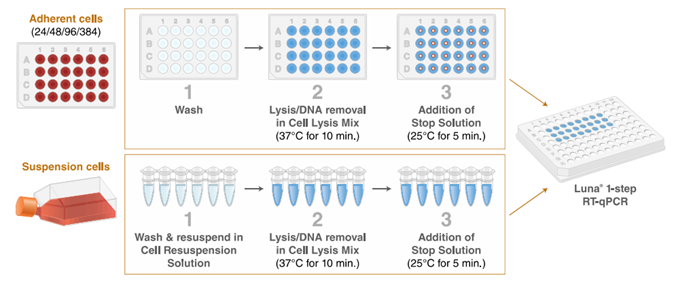上海金畔生物科技有限公司代理New England Biolabs(NEB)酶试剂全线产品,欢迎访问官网了解更多产品信息和订购。
产品信息

细胞培养常替代活体生物用于分析基因表达或治疗反应。传统上,人们通过柱提法或化学试剂法从处理过的细胞中提取和纯化 RNA。Luna Cell Ready 裂解模块无需进行传统的 RNA 提取步骤即可评估 RNA 表达水平,是一种快速、方便且灵敏的替代方案。此模块可同时进行细胞裂解、RNA 释放、基因组 DNA 去除,生成的细胞裂解物可直接使用 Luna 通用一步法 RT-qPCR 试剂盒进行 RT-qPCR 分析。与其它 Luna 产品一样,裂解缓冲液包含惰性蓝色示踪染料,使得整个流程可视化。
兼容 Luna Cell Ready 裂解模块的细胞系如下表所示。这些细胞进行 5 个 10 倍梯度稀释(在 50 µl 体系中裂解 10 – 100,000 个细胞),并取 1 µl 裂解物在 20 µl 体系中进行一步法 RT-qPCR 反应。每个细胞系的线性结果区域显示在最后一列。此外,上述裂解模块经测试也可用于一些昆虫细胞系。
表 1:验证过的细胞系
| 细胞系 | 特性 | 种属 | 50 μl 裂解体系中的细胞数量 |
|---|---|---|---|
| A549 | 贴壁培养 | 人肺癌细胞 | 10 – 100,000 |
| HEK293 | 贴壁培养 | 人肾脏细胞 | 10 – 100,000 |
| HeLa | 贴壁培养 | 人子宫颈腺癌细胞 | 10 – 100,000 |
| HepG2 | 贴壁培养 | 人肝脏癌细胞 | 10 – 1,000 |
| NCI-H460 | 贴壁培养 | 人肺癌细胞 | 10 – 100,000 |
| SK-N-SH | 贴壁培养 | 人脑成神经细胞瘤细胞 | 10 – 10,000 |
| U2Os | 贴壁培养 | 人骨骼骨肉瘤细胞 | 10 – 100,000 |
| Jurkat | 悬浮培养 | 人 T 淋巴细胞白血病细胞 | 10 – 100,000 |
| K-562 | 悬浮培养 | 人成淋巴细胞白血病细胞 | 10 – 100,000 |

- 产品类别:
- Luna® qPCR & RT-qPCR Products,
- PCR, qPCR & Amplification Technologies Products
- 应用:
- qPCR & RT-qPCR,
- DNA Amplification, PCR & qPCR
-
试剂盒组成
本产品提供以下试剂或组分:
NEB # 名称 组分货号 储存温度 数量 浓度 -
E3032S -20 Luna Cell Ready Lysis Buffer B8036AVIAL -20 2 x 1.4 ml 2 X Luna Cell Ready RNA Protection Reagent M0469AVIAL -20 1 x 0.25 ml 25 X Luna Cell Ready Protease M0473AVIAL -20 1 x 0.2 ml 25 X Luna Cell Ready Stop Solution B8037AVIAL -20 1 x 0.6 ml 10 X DNase I (RNase-free)
M0474AVIAL -20 1 x 0.5 ml 10 X
-
-
特性和用法
需要但不提供的材料
- 磷酸盐缓冲液(PBS)
- 细胞
- Eppendorf 管
- PCR 联管
- PCR 板
- 移液器和移液枪头(为减少交叉污染,应使用带滤芯的枪头)
操作说明、说明书 & 用法
-
操作说明
- Protocol for Luna® Cell Ready Lysis Module (NEB #E3032)
-
说明书
产品说明书包含产品使用的详细信息、产品配方和质控分析。- manualE3032
-
应用实例
- High-throughput qPCR and RT-qPCR Workflows Enabled by Beckman Coulter Echo Acoustic Liquid Handling and NEB Luna Reagents
- Facilitating Detection of SARS-CoV-2 Directly from Patient Samples: Precursor Studies with RT-qPCR and Colorimetric RT-LAMP Reagents
FAQs & 问题解决指南
-
FAQs
- What cell lines are compatible with the Luna Cell Ready Lysis Module (NEB #E3032)?
- How many cells should I use for reliable detection?
- How many cells should I seed into cell culture plates to achieve optimal detection?
- Can cryopreserved cell lines or pelleted cells stored at -80°C be used with this kit?
- How can lysis efficiency be determined?
- Why is it important to evaluate RNA damage or inhibition during cell lysis and one-step RT-qPCR detection?
- What is the “Luna Cell Ready RNA Protection Reagent” and when should it be used?
- Should I include a No-RT control reaction?
- Will the blue tracking dye interfere with detection?
- Is cell washing prior to lysis necessary?
- Which lysis format should I use?
- What protocol should be used for cell lysis? Can cells be lysed at room temperature or using a short protocol?
- Can I use the cell lysates generated from the Luna Cell Ready Lysis Module for two-step RT-qPCR?
- When using cell lysates generated from Luna Cell Ready Lysis Module, can RT-qPCR experiments be set up at room temperature?
- How much cell lysate should I use as input? (NEB #3030)
- Why does the Luna Cell Ready One-Step RT-qPCR Kit contain more RT-qPCR reactions than lysis reactions?
- If either the Luna Cell Ready Lysis Module or Luna Universal One-Step RT-qPCR Kit runs out, can I order them separately?
- How can I obtain more technical help related to Luna Universal One-Step RT-qPCR Kit?
